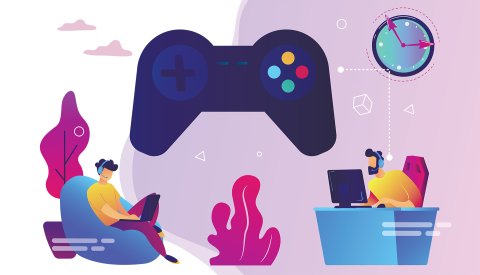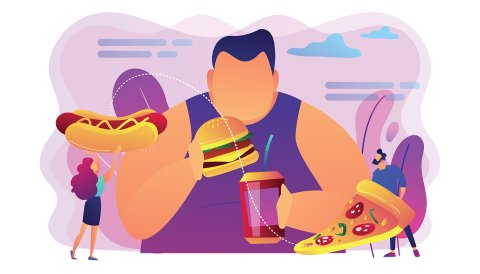One summer day in 2010, a Swedish graduate student named Daniel Berg approached me after a talk I gave at Christ's College, Cambridge. During the talk, I had casually mentioned internet addiction. Berg told me that I had spoken a truth larger than I knew. Many of his male friends at Stockholm University had dropped out of school and were living in crash pads, compulsively playing World of Warcraft. They spoke an argot more English than Swedish. It was all raiding, all the time.
"How do they feel about their situation?" I asked.
"They feel angst," Berg said.
"But they keep playing?"
"They keep playing."
This sort of behavior does seem like an addiction, in the sense of a compulsive, regret-filled pursuit of transient pleasures that are harmful to both the individual and society. For gaming, the personal cost was highest for Swedish men. "I am," Berg reported, "now the only male in my graduate program in economic history."
Back home in Florida, I noticed digital distractions exacting a more impartial academic toll. The smartphones that dotted the lecture halls were as often wielded by women as by men. But when I told Berg's tale to my students, they instantly recognized the type. One admitted that he had lost a year to compulsive gaming but was in recovery—precariously, to judge by his grades. Another knew gamers who kept cans by their computers to avoid taking bathroom breaks.
The can by the computer became for me a symbol of the shifting meaning of addiction. As late as the 1970s, the word seldom referred to anything other than compulsive drug use. Over the next 40 years, however, the concept of addiction broadened. Memoirists confessed to addictions to gambling, sex, shopping and carbs. German sex therapists called internet porn a "gateway drug" that ensnared the young. A New York Times op-ed declared sugar to be addictive, "literally, in the same way as drugs." A toothless young New Zealand mother drank up to 10 liters of Coke a day, then splashed the headlines when she died of coronary arrhythmia. A 19-year-old truant in Jiangsu Province made the news when he hacked off his hand to cure his internet addiction. Chinese officials judged as many as 14 percent of his peers to be similarly hooked, and set up internet addiction rehabilitation camps. South Korea and Japan followed suit. Taiwanese legislators voted to fine parents who let their children spend too much time online, updating a law forbidding minors' smoking, drinking, drug-taking and betel-chewing. Only the last habit failed to appeal to Americans, 47 percent of whom showed signs of at least one behavioral or substance addiction disorder in any given year in the early 2000s.
Often they showed signs of more than one. Medical researchers have discovered that substance and behavioral addictions have similar natural histories. They produce similar brain changes; similar patterns of tolerance; and similar experiences of craving, intoxication and withdrawal. And they reveal similar genetic tendencies toward similar personality disorders and compulsions. The manic gambler and the casino barfly are apt to be one and the same. In 2013, the new edition of the bible of psychiatry, the Diagnostic and Statistical Manual of Mental Disorders: DSM-5, described gambling disorders in language indistinguishable from drug addiction. In 2018, the WHO made it official by adding "gaming disorder" to the revised International Classification of Diseases.
Not everyone was happy with all the talk of addiction. Clinicians avoided it for fear of discouraging or stigmatizing patients. Libertarians dismissed it as an excuse for lack of discipline. Social scientists attacked it as medical imperialism. Philosophers detected equivocation, the misleading practice of using the same word to describe different things. For now, I will stick to the term "addiction" since it provides a concise and universally understood way of referring to a pattern of compulsive, conditioned, relapse-prone and harmful behavior. Why has this pattern of harmful behavior become increasingly conspicuous and varied?

Digital Addictions
Internet addicts and food addicts are strikingly similar. Food addicts have to eat, while drug and gambling addicts at least have a shot at a clean break. Online temptation is well nigh inescapable, internet access having become an assumed feature of life in developed societies. Addiction therapists know the score. They aim for "abstinence from problematic applications and a controlled and balanced internet usage," just as food addiction recovery groups promote measured and balanced eating. The similarities do not end there. Both food and internet addicts become obsessed, lose control, display tolerance, manifest associated disorders like anxiety and impulsivity and experience depression during withdrawal. They often relapse and persist despite family badgering and social opprobrium. And their numbers have been growing. Surveys undertaken in the United States and Europe between 2000 and 2009 (before widespread smartphone use aggravated the situation) reported internet addiction prevalence rates between 1.5 and 8.2 percent. Chinese studies found values ranging from 2.4 to 6.4 percent, though some subgroups, such as Taiwanese university freshmen, approached an 18 percent addiction rate. In developed nations, internet addiction has become at least as common as food addiction. Among adolescents it is much more so.
Addiction to the internet and other electronic pastimes reveals itself most clearly in the harsh light of abstinence. In 2010, an international team of researchers asked 1000 college students from 10 countries to go without electronic media for 24 hours and to record how they felt. The typical response involved a combination of surprise, restlessness, boredom, isolation, anxiety and depression, often prefaced with a frank admission of excessive use and addiction that cut across cultures.
As with alcohol, drugs, processed food and gambling, electronic media consumption is subject to the principle of hormesis—or more simply, "stimulation." Stimulants often provide beneficial effects at low doses, harmful ones at high doses. Consumption runs along a spectrum from occasional, beneficial use to relieve boredom and boost morale—the digital equivalent of a coffee break—to heavy, escapist use that harms self and others. Clinicians differ over whether to call the latter condition internet addiction, internet addiction disorder, internet use disorder, pathological internet use disorder, or something else entirely. They do, however, discern a common denominator. The heaviest users are those who have come to strongly prefer recreational life online as a way of tuning out IRL (in real life) hassles. They behave much like machine gamblers slipping into the zone, save that most of their activities, such as massively multiplayer online role-playing games, have a social aspect that reinforces the virtual seduction. No self-respecting World of Warcraft DPS (a character who inflicts a large amount of damage per second) would want to miss their guild's next big raid. IRL types take a dim view of such pursuits. Teachers issue failing grades, parents threats, employers pink slips, spouses papers for divorce, and judges treatment orders for internet boot camps.
Libertarians and medicalization skeptics think forced treatment is absurd. The arguments over food addiction—Is it really an addiction like drugs? Is it an acquired brain disease to which some individuals are more susceptible than others?—have cropped up again over internet addiction. Only this time the debate has been messier, because internet addiction includes a much wider range of activities than compulsive eating. Among them are addiction to digital pornography, online gambling, video and role-playing games, adult-fantasy chatrooms, shopping on sites like eBay, social media platforms, and websurfing. Different groups of people display different types of addiction. Boys and men are more inclined to online video games and pornography, girls and women to visually oriented social media and compulsive buying. Some psychiatrists class the latter as an addiction, others as a type of obsessive-compulsive disorder.

Fear of Missing Out
Another thing that makes internet addiction difficult to assess is its relative novelty, especially habitual social media use via camera-equipped, internet-accessible mobile devices. Little historical perspective is available, though three things stand out.
First, digital connectivity and mobility have spawned genuinely new patterns of addictive behavior. Putting aside academic disputes over categories and causes, the behaviors themselves have become social facts. When I told people that I was writing an updated history of addiction, the near-universal response was that I should include kids glued to their smartphones. What had once been a peripheral nuisance has become a real worry, given the rising toll of accidents caused by distracted drivers, not to say reports of increased bullying, anxiety and academic failure. Compulsively studying social media posts leaves less time for studying everything else.
Second, the development of the internet created new, global opportunities for the dissemination of old vices and addictions, including gambling, psychoactive drugs, prostitution and pornography. Indeed, porn has accounted for a significant portion of internet traffic from the time of its commercial inception.
Third, both developments—new bad habits and new outlets for old ones—have been engineered to maximize revenue, data on consumers and time spent on the device or app. Attention is the key corporate asset and behavioral science the means to claim it. For every individual trying to exercise self-control over computer use, pointed out the ethicist Tristan Harris, there are a thousand experts whose job it is to break it down. Game makers study young players and analyze their mouse clicks to devise reinforcement schedules that prolong play and stimulate in-game product purchases.
All three aspects of digital vice and addiction—new, old, designed—figured in journalist Nancy Jo Sales' American Girls: Social Media and the Secret Lives of Teenagers (2016). Sales interviewed over 200 smartphone–equipped girls aged 13 to 19, about how social media had affected them.
Sales' subjects volunteered that they were addicted to or obsessed with their phones, internet videos and social media, to which the heaviest users devoted from nine to 11 hours a day. As with other addictions, reinforcement had a positive and negative dimension. Every like on a post or photo, every retweeted message, was a small psychic jackpot. The continual flow of information, especially information about where one stood in the hotness pecking order, was a potent form of reward. Not having access to that information was a source of gnawing anxiety. Like much else online, it acquired its own name, FOMO. Fear of Missing Out.
Yet boys too pay a price for easy, uncensored internet access. They become ensnared in a loutish bro culture and a world of pornographic fantasy that can result in sexual dysfunction. The reason college men are having trouble getting erections, a male Ivy League student told Sales, is excessive porn use.
It is as if, in the span of a century, there have been three revolutions of technology and sex. The first, artificial contraception, separated sex from procreation. The second, digital pornography, separated sex from physical contact between persons. And the third, online remoteness and impersonality, separated sex from courtship and its customary object, marriage. When sex is cheap, quick and always available, why bother with corsages, dinner dates and engagement rings?
As they multiplied, the digital hooks became sharper. In September 2006, Facebook was just another "fun" site, a novelty open to anyone who was 13 years old and in possession of a valid email address. Ten years later it was an obsession, with more than a billion daily active users, a claim on the attention of nearly 40 percent of the global online population, and the foundation of the world's fifth most valuable corporation. None of this was accidental. Designers of social media platforms and video games rely on pleasure's traditional art of combination. The difference is that, instead of sugar, salt and fat, they select from a menu of psychological ingredients. The big six are compelling goals just beyond the user's immediate reach; unpredictable but stimulating feedback; a sense of incremental progress and hard-won mastery; tasks or levels that gradually become more challenging; tensions that demand resolution; and social connections to like-minded users. Insiders call the social aspect the "rewards of the tribe." Tribes punish, too. "You've got to keep up with the virtual Joneses," explained Ryan Van Cleave, an English professor who lost his job at Clemson because he was playing World of Warcraft 60 hours a week. When he finally quit, to avoid losing his family, he suffered drenching sweats, nausea and headaches.
The primary danger, particularly with smartphones, is constant distraction from personal conversation, sleep, driving, study, reflection, practice and work, which translates into difficulty achieving or maintaining intimacy, health, safety, knowledge, creativity, expertise and socially constructive flow states. Like gambling machines, social media and other digital diversions offer alternative flow states through virtual shortcuts that exact their price in money, time and diminished real-life accomplishments, satisfactions and tolerance for electronically unvarnished life itself.
"Facebook remains the greatest distraction from work I've ever had," the writer Zadie Smith confessed, "and I loved it for that." With a literary career at stake, she broke off the affair after two months. She was wise to do so. The novelist Jonathan Franzen, who wrote portions of The Corrections wearing a blindfold and earplugs, doubted whether anyone working with an internet connection was capable of writing good fiction. Professors doubted whether students so equipped could sustain original arguments, fears borne out by research showing social media use inversely correlated with grades. Psychologists showed that mere proximity to a silenced smartphone diminishes cognitive ability, particularly in habitual users. Lit up or vibrating, the devices are guaranteed to divert attention, as is any form of regular online access.
The condition acquired a name, "time suck," defined in the Urban Dictionary as something "engrossing and addictive, but that keeps you from doing things that are actually important, like earning a living, or eating meals or caring for your children." Like other forms of addictive behavior, time suck is self-perpetuating. If dereliction from real-life duties creates stress, or immersion in the virtual world creates loneliness, anxiety and depression, then escapism is just the thing. George Koob, the director of the National Institute on Alcohol Abuse and Alcoholism (NIAAA) said, "People often drink because they don't feel good, but drinking makes them feel worse, so they drink more." This applies equally to digital addictions.
In 2017, Loren Brichter, who created the pull-to-refresh mechanism by which users of Twitter and other apps could update their feeds by swiping down on the touchscreen, said he regretted his invention. He called it addictive, a lever on a slot machine. Justin Rosenstein, who coded the like-button prototype, wished he had not bestowed "bright dings of pseudo-pleasure" on a distracted world. Chamath Palihapitiya, Facebook's former vice president for user growth, hated that "the short-term, dopamine-driven feedback loops that we have created are destroying how society works. No civil discourse. No cooperation. Misinformation. Mistruth." It was not, he emphasized, an American problem. It was a global problem. Capturing and monetizing eyeballs had become an irresistible game.
Repentant or not, Silicon Valley elites watched out for the eyeballs of their own families. "We limit how much technology our kids use at home," Apple's Steve Jobs told an incredulous reporter, who had imagined his dining table tiled with iPads. "Not even close," Jobs said. He wanted his children to discuss books and history at family meals. The five children of Chris Anderson, former editor of Wired, complained of their parents' tech-denying rules. "That's because we have seen the dangers of technology firsthand," Anderson told the same reporter. "I've seen it in myself, I don't want to see that happen to my kids." Palihapitiya was more explicit. He didn't use "this shit" and wouldn't let his kids, either. Other tech executives and engineers dealt with the problem by imposing time limits, refusing phones to their kids before their mid-teens and never allowing screens in their bedrooms. Extending the low-tech writ beyond their homes, they enrolled their children in prep schools where iPhones, iPads and even standard laptops were forbidden.
The Age of Addiction
The medical historian Charles Rosenberg wrote that "in some ways, disease does not exist until we have agreed that it does—by perceiving, naming and responding to it." That goes double for new addictions: we are in a bull market for perceiving, naming and responding to them, socially manufactured or otherwise. In the end, though, it matters less what we call these excesses than that we understand their price. We not only live in an age of addiction. We live in an age when the commercialized temptation to downshift our brains from disciplined, cortical pleasures to baser ones has never been more intense. Like never before, bad habits are big business.
→ Excerpt adapted from THE AGE OF
ADDICTION: HOW BAD HABITS BECAME BIG BUSINESS, published by Harvard University Press. Copyright © 2019 by the President and Fellows of Harvard College. Used by permission. All rights reserved.












